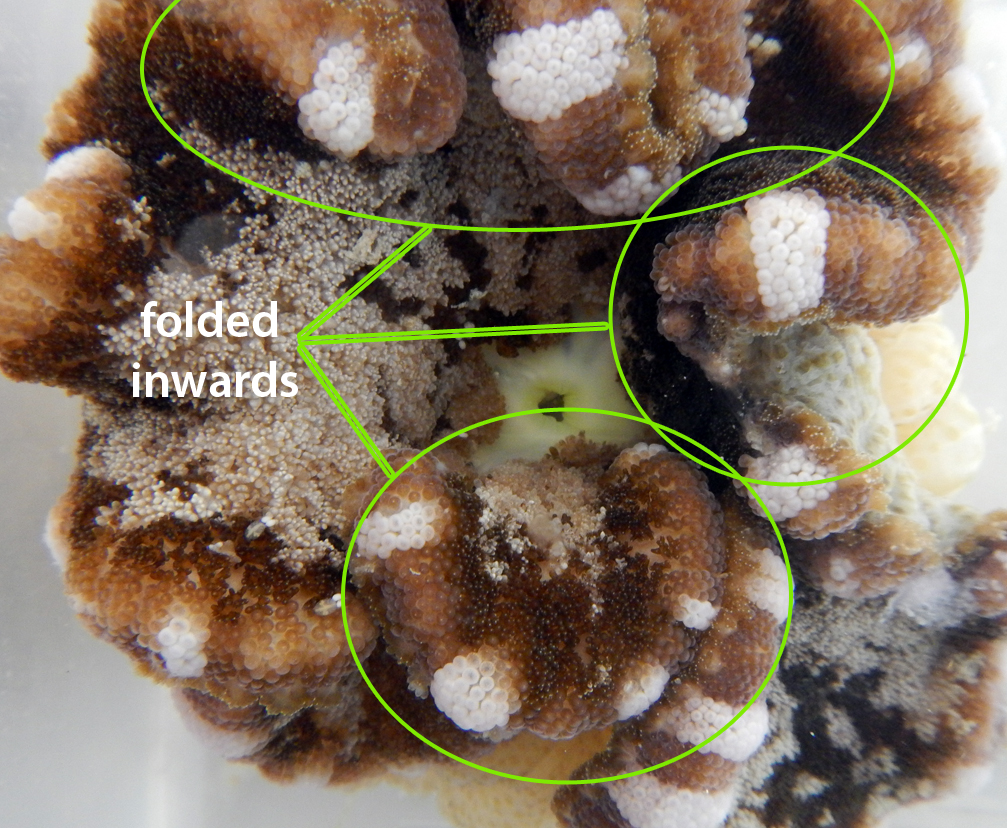Summary
Physical Description
Ecology
Symbiosis
Life History & Behavior
Feeding Behavior
Movement
Reproduction and Development
Respiration
Response to Light Changes
Anatomy & Physiology
Circulatory and Excretory Systems
Defense Mechanisms: Cnidocytes and Cnidae
Digestive System
Nervous and Sensory Systems
Skeleton and Musculature
Evolution and Systematics
Biogeographic Distribution
Conservation and Threats
References and Links | Response to Light Changes
Materials and Methods
Cryptodendrum adhaesivum was subjected to two conditions, with light or without light, that alternated every hour over a time period of 12 hours. It was first placed in an aquarium outdoors and left overnight. The next day, at 0500 hours, a garbage bag was wrapped around the aquarium and a tray was placed over the top to block out any light that may pass through. At 0600 hours, the tray was lifted slightly and an underwater camera was used to take a photograph of C. adhaesivum, while taking care not to expose it to any light. The garbage bags and the tray were then removed, and C. adhaesivum was left exposed to sunlight. At 0700 hours, a photograph was taken again and the garbage bags and tray were used again to block out the light for the next hour. Exposing C. adhaesivum to hourly changes in lighting conditions was repeated until 1700 hours in the evening.
C. adhaesivum was assessed to either be 'open' or 'closed' with respect to the varying lighting conditions. It was defined to be 'open' when its oral disc was expanded and the undulations on the side were folded outwards. Below is an example of 'opened up':

It was defined to be 'closed' when at least four undulations were curled up inwards towards the mouth:

Results
C. adhaesivum was observed to change its physical form under different lighting conditions (Figure 1).

Figure 1. Observations of C. adhaesivum under different lighting conditions. Orange circles indicate an expanded oral disc. Red circles and ellipses denote a change in undulation: folding outwards for an 'open' status and folding inwards for a 'closed' status.
Discussion
C. adhaesivum was observed to 'open up' when exposed to light and to 'close up' when it was dark. Although the changes were obvious most of the time it was not as obvious between 1400—1500 hours. This could possibly be because C. adhaesivum was not under direct sunlight at that time interval, as opposed to the other 'light' time intervals when it was actually sitting in the aquarium under direct sunlight.
Similar to this study, it has been found that some sea anemones react to visible light and will expand fully1. The reactions of sea anemones to light are varied; a large number of genera have been noted to expand in twilight and contract in daylight while others have been reported to expand in light and contract in the dark. In other species, conspecifics from different habitats have been observed to behavior in an opposite manner2. As such, there does not seem to be any universal behavior that seems to apply across the entire order Actinaria. Both light and oxygen have also been noted to cause separate and interacting effects on sea anemone behavior; for example, some studies have indicated that the endosymbiotic algae are the mediators of the expanding behavior3 and expansion in daylight promotes photosynthesis4. On the other hand, oxygen levels have been suggested to be a factor that stimulates the oral disc to expand1,5. As for expansion at night, a study on tropical reef anemones proposed that this was related to zooplankton availability4.
Although the most commonly observed reaction to darkness is contraction, contraction can be triggered by a range of other stimulus such as air exposure, vigorous mechanical or electrical stimulation and water movement6,7,8. For instance, contracting in slack water can apparently reduce the rate of aerobic metabolism when few prey are available and hence conserves energy for the sea anemone. However, partial expansion may occur in waters rich in suspended particulate detritus to maximize detritus capture through gravitational deposition3.
Nevertheless, the multitude of possible reasons that can explain this behavior highlights the need to conduct more research. Moreover, to date, no light-response study that specifically involves C. adhaesivum has been done, although regular expansion in light and contraction in the dark have been noted in other anemone species such as Anthopleura elegantissima. Hence it is difficult to affirm the results from this study. Additionally, only one individual was involved in this experiment, and it is not known if the observations are a result of unique individual traits. Thus, more replicates should be used in the future. Other possible avenues to complement this experiment include incorporating more parameters that may affect anemone behavior to light, such as stagnant or running water, modifying levels of symbiotic zooxanthellae, and comparing the response of individuals from different habitats with varying light intensities. Additionally, further research could look at using a wider range of light intensities and to affirm whether C. adhaesivum display phototaxis.
1Shick & Brown 1977
2Pearse 1974
3Shick 1991
4Sebens & DeRiemer 1977
5Fredericks 1976
6Parker 1917
7Hall & Pantin 19378
8di Milia & Geppetti 1964
|
|